Hudson's Bay Company
The Most Important Industry in North America
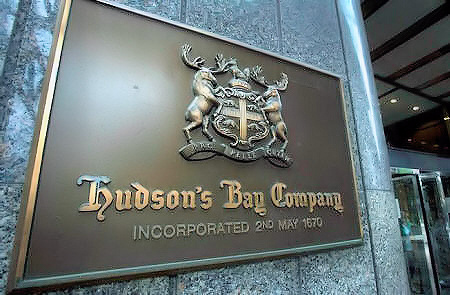 was
an English corporation formed in 1670,
when Charles II, king of England,
granted a charter to Prince Rupert, his
Bohemian-born cousin, and 17 other
noblemen and gentlemen, thus giving them
a monopoly over trade in the region
watered by streams flowing into Hudson
Bay. In the vast territory, which came
to be known as Rupert's Land, their
company also had the power to establish
laws and impose penalties for the
infraction of the laws, to erect forts,
to maintain ships of war, and to
make peace or war with the natives. The
original capital of the company was
about $220,000, a large amount of
capital for the period.
was
an English corporation formed in 1670,
when Charles II, king of England,
granted a charter to Prince Rupert, his
Bohemian-born cousin, and 17 other
noblemen and gentlemen, thus giving them
a monopoly over trade in the region
watered by streams flowing into Hudson
Bay. In the vast territory, which came
to be known as Rupert's Land, their
company also had the power to establish
laws and impose penalties for the
infraction of the laws, to erect forts,
to maintain ships of war, and to
make peace or war with the natives. The
original capital of the company was
about $220,000, a large amount of
capital for the period.
For almost a century this monopoly went unquestioned, although it had developed slowly. By 1749 the company had only four or five coastal forts and no more than 120 employees. The annual trade, although immensely profitable, consisted only of the barter of three or four shiploads of coarse British goods for an approximately equal weight of furs and skins. In that year, an unsuccessful attempt was made in Parliament to revoke the charter on the grounds that the powers it provided had not been used. After this period the development of the company speeded up. Conflicts with the French over the fur trade, which had begun with the birth of Hudson's Bay Company and had broken out into an open war settled in favor of the company in 1713, were finally resolved by the British conquest of Canada in 1763. The acquisition of Canada made the territories of the company accessible from the south as well as from the sea; trade increased immensely, and during the French wars from 1778 to 1783 the company was strong enough to bear a loss of approximately one million dollars.
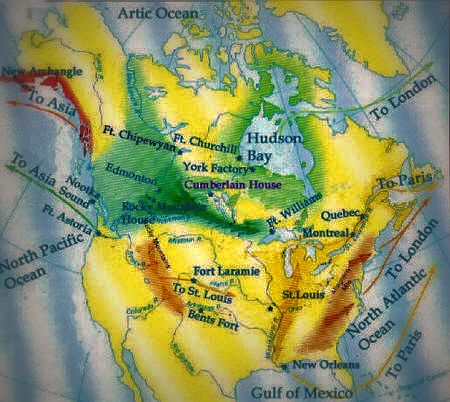 A
monopoly so profitable could not
long be maintained. Private trappers and
even rival companies soon entered the
field, penetrating from the Great Lakes
far up the Saskatchewan River toward the
Rocky Mountains. In 1783 a group of
these speculators formed the North West
Fur Company of Montreal and entered into
fierce competition with the Hudson's Bay
Company. During the following years the
supply of fur-bearing animals was
threatened by the slaughter of
animals during the breeding season.
Eventually, in 1821, the two
great companies merged, with a combined
territory extended by a license to the
Arctic Ocean on the north and the
Pacific Ocean on the west. In 1838 the
Hudson's Bay Company again acquired the
sole rights of the trade in this area
for a period of 21 years. At the
expiration of the new license in 1859,
however, the trade monopoly was
abolished and trade in the region was
opened to any entrepreneur. The claims
of the company to vested interest and
property rights, however, remained
unsettled until 1870, when Rupert's Land
was acquired by the Dominion of Canada
in return for an indemnity of
approximately $600,000 and a land grant
of 7 million acres. The company retained
its forts and trading posts, but gave up
all monopolistic privileges.
A
monopoly so profitable could not
long be maintained. Private trappers and
even rival companies soon entered the
field, penetrating from the Great Lakes
far up the Saskatchewan River toward the
Rocky Mountains. In 1783 a group of
these speculators formed the North West
Fur Company of Montreal and entered into
fierce competition with the Hudson's Bay
Company. During the following years the
supply of fur-bearing animals was
threatened by the slaughter of
animals during the breeding season.
Eventually, in 1821, the two
great companies merged, with a combined
territory extended by a license to the
Arctic Ocean on the north and the
Pacific Ocean on the west. In 1838 the
Hudson's Bay Company again acquired the
sole rights of the trade in this area
for a period of 21 years. At the
expiration of the new license in 1859,
however, the trade monopoly was
abolished and trade in the region was
opened to any entrepreneur. The claims
of the company to vested interest and
property rights, however, remained
unsettled until 1870, when Rupert's Land
was acquired by the Dominion of Canada
in return for an indemnity of
approximately $600,000 and a land grant
of 7 million acres. The company retained
its forts and trading posts, but gave up
all monopolistic privileges.
Parts of the remnant of its once vast land empire were sold, and the company now holds only about 2 million acres; the income from these sales was added to the assets of the company for enterprises in new fields. During World War I the Hudson's Bay Company operated a steamship line with more than 300 vessels and transported food and munitions for the French and Belgian governments. It Built a chain of department stores in western Canada, the largest of which are in Winnipeg, Saskatoon, Calgary, Edmonton, Vancouver, and Victoria. The Beaver House, the warehouse of the Hudson's Bay Company in London, became a center of the international fur trade. More recently the company has extended its fur trading outside Canada, especially in Russia, and de-emphasized the retailing of furs. Due to economic factors, the company dosed the last of its retail fur salons in 1991.
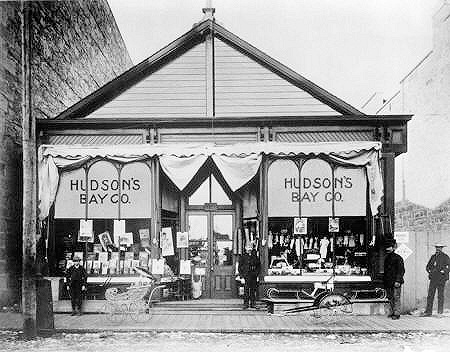 The
Hudson's Bay Company was founded May 2,
1670, by charter from the British crown.
The regal charter granted the Company
absolute proprietorship, supreme
jurisdiction in all civil and military
affairs, the power to make and interpret
laws, and even the power to declare war
against "pagan" peoples. The charter
granted the Company access to all lands
drained by the rivers that entered
Hudson's Bay, called Rupert Land, and
included territory in what is now
Minnesota, North Dakota and Montana. The
leaders literally had the power of life
and death over employees and the people
who lived within Hudson's Bay Company
domain.
The
Hudson's Bay Company was founded May 2,
1670, by charter from the British crown.
The regal charter granted the Company
absolute proprietorship, supreme
jurisdiction in all civil and military
affairs, the power to make and interpret
laws, and even the power to declare war
against "pagan" peoples. The charter
granted the Company access to all lands
drained by the rivers that entered
Hudson's Bay, called Rupert Land, and
included territory in what is now
Minnesota, North Dakota and Montana. The
leaders literally had the power of life
and death over employees and the people
who lived within Hudson's Bay Company
domain.
Based in London and with a major North American office in Montreal, "the Company," as it was known, had its eyes on western North America for the express purpose of obtaining furs. Consequently, western expansion was a main objective. Western expansion also meant southern expansion, which caused a few problems. Since the American-Canadian border was not defined as the 49th parallel east of the Rocky Mountains until 1818, and it was not until 1846 that that border was extended to the Pacific Ocean, both sides trapped as they pleased. A company laid claim to an area and did everything in its power to discourage intruders.
The Hudson's Bay Company was not bashful about extending its reach south. Several expeditions extensively explored the area of southern Montana and Idaho. The Hudson's Bay Company had its initials "HBC" on its property wherever it was located. Americans seeing these initials seemingly everywhere jokingly referred to the letters as meaning "Here Before Christ."
In the autumn of 1810, Hudson's Bay trader Joseph Howse built a small fur fort on the north end of Flathead Lake. (Nobody knows for sure where this post was located.) It was occupied through the winter of 1810-11 and abandoned in the spring. The purpose of the post was to counteract the presence of the North West Company in the Northwest. Howse House or Fort Howse has the distinction of being the only fort built by the Hudson's Bay Company west of the Rocky Mountains until consolidation with the North West Company in 1821.
 In
1824 the Hudson's Bay Company built its
Columbia Department headquarters on the
Columbia River at Fort Vancouver
(Washington) and named the shrewd Dr.
John McLoughlin as governor. He sent
brigades from Fort Vancouver and
explored the northwest, reaching as far
as western Montana. Trapping and trading
continued for many years into the
western reaches of Montana and Idaho;
Hudson's Bay Company was reluctant to
give up the rich trapping grounds.
In
1824 the Hudson's Bay Company built its
Columbia Department headquarters on the
Columbia River at Fort Vancouver
(Washington) and named the shrewd Dr.
John McLoughlin as governor. He sent
brigades from Fort Vancouver and
explored the northwest, reaching as far
as western Montana. Trapping and trading
continued for many years into the
western reaches of Montana and Idaho;
Hudson's Bay Company was reluctant to
give up the rich trapping grounds.
Between 1811 and 1824 the Hudson's Bay Company kept an active presence in northwest Montana. What fur forts they operated largely have been forgotten. Writings from the period indicate that the Company always maintained a trading post in the area. Flathead Post (also called the second Salish House) was established in 1823 by Alexander Ross about five miles east of Thompson Falls.
February 10, 1824, Ross, who was charged with the lucrative Snake River trade, set out from Flathead Post near Thompson Falls for a winter trapping and exploring venture. His party consisted of 140 persons, some of whom were family members of the trappers, as well as a few Iroquois Indians hired to trap and to teach trapping techniques to the local natives.
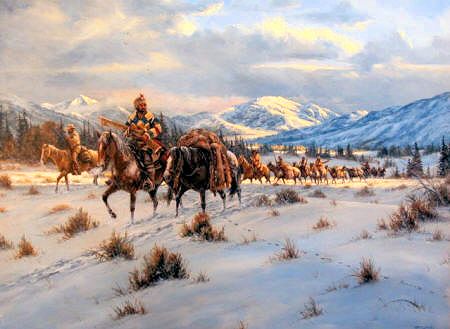 Ross's
journey took him to Hell Gate Valley
near Missoula, up the Bitterroot River
through the Bitterroot Valley, and on
March 12 to Ross's Hole (which Ross
called the Valley of Troubles) near
Sula. Snow was deep; temperatures were
near zero; and, passage east over the
densely forested hills into the Big Hole
Valley was next to impossible. For a few
days, Ross waited for orders to turn
back. When none came, amidst grumbling
and near mutiny by his men, he started
working his way east (via present-day
Gibbons Pass) through ten-foot-high
snowdrifts with the objective of
reaching the Big Hole Valley. Men
threatened to desert, so Ross promised
to take the clothes of any persons
caught deserting. The prospect of nudity
in the spring mountains amidst those
ten-foot snowdrifts changed all mutinous
minds.
Ross's
journey took him to Hell Gate Valley
near Missoula, up the Bitterroot River
through the Bitterroot Valley, and on
March 12 to Ross's Hole (which Ross
called the Valley of Troubles) near
Sula. Snow was deep; temperatures were
near zero; and, passage east over the
densely forested hills into the Big Hole
Valley was next to impossible. For a few
days, Ross waited for orders to turn
back. When none came, amidst grumbling
and near mutiny by his men, he started
working his way east (via present-day
Gibbons Pass) through ten-foot-high
snowdrifts with the objective of
reaching the Big Hole Valley. Men
threatened to desert, so Ross promised
to take the clothes of any persons
caught deserting. The prospect of nudity
in the spring mountains amidst those
ten-foot snowdrifts changed all mutinous
minds.
Tempers often ran high, but one month later, on April 14, after a fifteen-hour day of pandemonium, the group broke over the top into the Big Hole Valley. They remained in the Big Hole for twelve days enjoying the Boiling Spring at Jackson, where William Clark and nineteen of his men had camped in July of 1806.
Ross and his expedition trapped the Big Hole River and Willard's Creek - later to be known as Grasshopper Creek - and perhaps even at Bannack, the site of the first major gold strike in Montana in 1862. Ross then ventured into the Salmon River country via Lemhi Pass near Tendoy and Salmon, Idaho, and trapped that region extensively. In November of 1824 they returned to Flathead Post with the best return ever from a brigade's expedition and from the Snake River country - over 5,000 furs. When he returned, Ross was given command of Flathead Post, and Peter Skene Ogden replaced him as the head of the Snake River trade.
Between 1824 and 1830 Peter Skene Ogden led six forays into the immense drainages of the Snake River on behalf of the Hudson's Bay Company's Columbia Department. Reports abounded of the Snake River region being as rich a trapping field as could be found. In the years that followed, the Hudson's Bay Company increased its brigades in the field, adding James W. Dease and John Work as brigade leaders. The target was the fur-rich rivers and drainages of the Snake, dark's Fork of the Columbia, and Missouri.
 John
Work, in charge of the Snake River
brigade from 1831 until 1834, set out
from Fort Nez Perce (Walla Walla) on
September 11, 1831. His objective was
trade with the Salish and Blackfeet
Indians. With this enterprising group
were various family members of trappers
and traders, including Work's three
small daughters and someone he called
his "little Walla Walla Indian
housekeeper" as babysitter. Like most
other trapping expeditions, this one
also included clerks and storekeepers
who would look after such trading items
as guns, beads, vermilion, axes,
mirrors, knives, blankets, coffee, clay
pipes and tobacco. Whenever the
expedition encountered Indians with
furs, these men would set up shop. Their
take on some days understandably would
be greater than what the trappers would
bring in from the field.
John
Work, in charge of the Snake River
brigade from 1831 until 1834, set out
from Fort Nez Perce (Walla Walla) on
September 11, 1831. His objective was
trade with the Salish and Blackfeet
Indians. With this enterprising group
were various family members of trappers
and traders, including Work's three
small daughters and someone he called
his "little Walla Walla Indian
housekeeper" as babysitter. Like most
other trapping expeditions, this one
also included clerks and storekeepers
who would look after such trading items
as guns, beads, vermilion, axes,
mirrors, knives, blankets, coffee, clay
pipes and tobacco. Whenever the
expedition encountered Indians with
furs, these men would set up shop. Their
take on some days understandably would
be greater than what the trappers would
bring in from the field.
Work and his party traveled east following the Clearwater River in part, over Lolo Pass, and ended up at Lolo Hot Springs, Montana, on October 13, 1831. Work reported many beaver taken, as well as deer, elk, bear and sheep. The party met the Bitterroot River (named for the flower that grows in profusion on its banks) near the present town of Lolo and followed it to Hell Gate Valley (Missoula) where they spent the night of October 20. Ten days later, just west of Ovando near Monture Creek, Work lamented in his journal: "Some marks of the Americans are seen. The Indians [with him] had hunted the little forks up this far, and probably all above this is hunted by Americans, so that nothing is left for us."
Within several weeks of leaving Hell Gate Valley, Work lost several of his men to Blackfeet attacks. From Hell Gate he had moved to trap the area of Deer Lodge, Divide, and the Beaverhead Valley. Thursday, November 17, 1831, he noted the Beaverhead Rock south of Dillon, which had been mentioned by Lewis and dark on August 10, 1805. Work also noted immense herds of buffalo in the area, and how fat they were.
He and his group journeyed via Shoshone Cove, or Horse Prairie, to the Salmon River country, spending nearly a month trapping. January 4, 1832, he reentered Montana and trapped the Beaverhead Valley once more from Red Rock near dark Canyon Dam to the Point of Rocks near Twin Bridges. He especially liked the Beaverhead because of the abundance of buffalo for food, and the wide open spaces in which he could spot Blackfeet or other bands of Indians.
From January 28 until February 3, 1832, John Work's expedition was camped about ten miles north of Dillon, about where the railroad terminus Apex is now located. He remained in camp longer than was usual because the sick and wounded were unable to move and the weather was inclement. On Monday, January 30, the group was attacked at daybreak by a party of at least 300 Piegans (Blackfeet) and Gros Ventres. The attack lasted until noon, Work's group sustaining one Flathead killed and eight wounded. Work's arm was slightly injured and his "Walla Walla Indian housekeeper dangerously wounded." He recorded in his journal, "A brisk fire was kept up on both sides until noon, at one time they had surrounded our camp, but kept a considerable distance." The cannon Work had with him burst on the third discharge, and was presumably left, becoming the object of searches years later. Work and his party left Montana via Horse Prairie and Bannack Pass the second week of March, encountering many other adventures along the way. His exciting expedition was not unlike others to the fur beds of the West; only the locations differed.
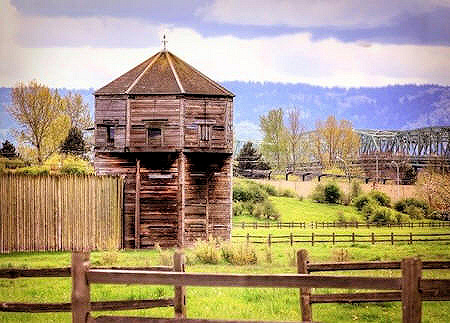 Trapping
generally was productive in spite of the
harassment by the Blackfeet Indians. The
number of animal pelts grew steadily
until 1837, when one source lists the
Hudson's Bay Company's harvest at 26,735
pelts. Then, the number of beaver in the
region steadily declined because of the
heavy trapping pressure. In spite of
many areas being trapped out, exciting
trapping forays continued.
Trapping
generally was productive in spite of the
harassment by the Blackfeet Indians. The
number of animal pelts grew steadily
until 1837, when one source lists the
Hudson's Bay Company's harvest at 26,735
pelts. Then, the number of beaver in the
region steadily declined because of the
heavy trapping pressure. In spite of
many areas being trapped out, exciting
trapping forays continued.
The Americans were invading the region in greater numbers and were claiming the territory as their own with greater frequency and enthusiasm. In the Flathead country, vigorous measures were taken to overcome American aggressiveness. Flathead Post was moved farther east to ward off American ventures and ultimately was moved to Post Creek near Ronan and Charlo and renamed Fort Connah. In 1847, Angus McDonald completed construction of Fort Connah, which has the distinction of being the last Hudson's Bay Company post to be constructed in what is now the United States. In 1871 Fort Connah was closed by Duncan McDonald, son of old Angus who had opened it twenty-five years before.
The day of the beaver-fur trade had begun to close in western Montana by the early 1850s. Many Indians and whites continued to hunt and trap furs and sell or trade them at such places as Fort Owen in the Bitterroot near Stevensville or Fort Connah. Silk had replaced beaver in its value for hats, and buffalo had become the fur of choice. The days of the romantic fur trade were over.